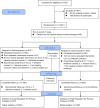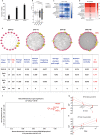Detection of an anti-angina therapeutic module in the effective population treated by a multi-target drug Danhong injection: a randomized trial
- PMID: 34471087
- PMCID: PMC8410855
- DOI: 10.1038/s41392-021-00741-x
Detection of an anti-angina therapeutic module in the effective population treated by a multi-target drug Danhong injection: a randomized trial
Abstract
It's a challenge for detecting the therapeutic targets of a polypharmacological drug from variations in the responsed networks in the differentiated populations with complex diseases, as stable coronary heart disease. Here, in an adaptive, 31-center, randomized, double-blind trial involving 920 patients with moderate symptomatic stable angina treated by 14-day Danhong injection(DHI), a kind of polypharmacological drug with high quality control, or placebo (0.9% saline), with 76-day following-up, we firstly confirmed that DHI could increase the proportion of patients with clinically significant changes on angina-frequency assessed by Seattle Angina Questionnaire (ΔSAQ-AF ≥ 20) (12.78% at Day 30, 95% confidence interval [CI] 5.86-19.71%, P = 0.0003, 13.82% at Day 60, 95% CI 6.82-20.82%, P = 0.0001 and 8.95% at Day 90, 95% CI 2.06-15.85%, P = 0.01). We also found that there were no significant differences in new-onset major vascular events (P = 0.8502) and serious adverse events (P = 0.9105) between DHI and placebo. After performing the RNA sequencing in 62 selected patients, we developed a systemic modular approach to identify differentially expressed modules (DEMs) of DHI with the Zsummary value less than 0 compared with the control group, calculated by weighted gene co-expression network analysis (WGCNA), and sketched out the basic framework on a modular map with 25 functional modules targeted by DHI. Furthermore, the effective therapeutic module (ETM), defined as the highest correlation value with the phenotype alteration (ΔSAQ-AF, the change in SAQ-AF at Day 30 from baseline) calculated by WGCNA, was identified in the population with the best effect (ΔSAQ-AF ≥ 40), which is related to anticoagulation and regulation of cholesterol metabolism. We assessed the modular flexibility of this ETM using the global topological D value based on Euclidean distance, which is correlated with phenotype alteration (r2: 0.8204, P = 0.019) by linear regression. Our study identified the anti-angina therapeutic module in the effective population treated by the multi-target drug. Modular methods facilitate the discovery of network pharmacological mechanisms and the advancement of precision medicine. (ClinicalTrials.gov identifier: NCT01681316).
© 2021. The Author(s).
Conflict of interest statement
The authors declare no competing interests.
Figures






References
-
- Mozaffarian D, et al. Heart disease and stroke statistics-2015 update: a report from the American Heart Association. Circulation. 2015;131:e29–e322. - PubMed
Publication types
MeSH terms
Substances
Associated data
LinkOut - more resources
Full Text Sources
Medical

